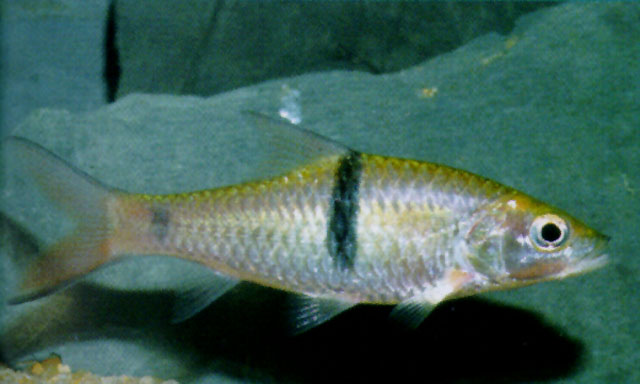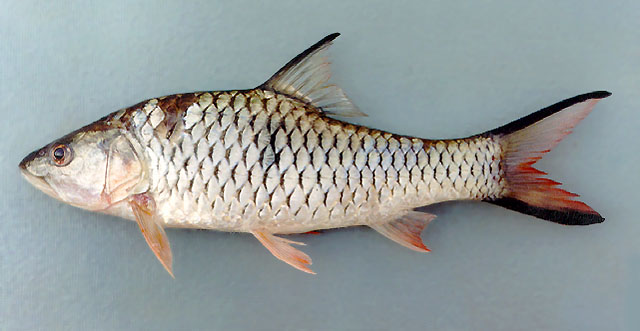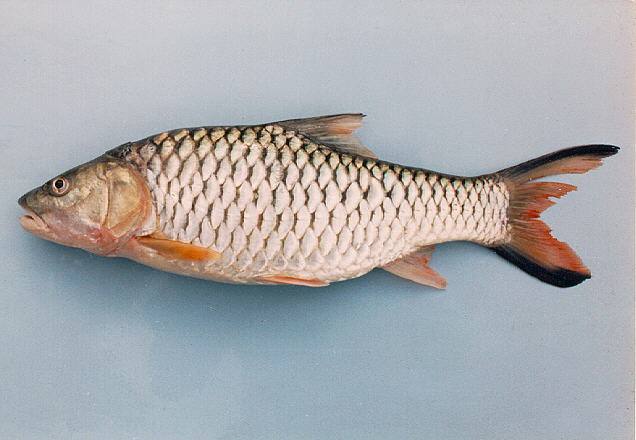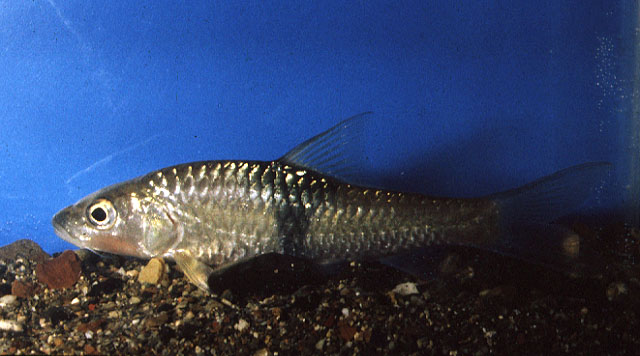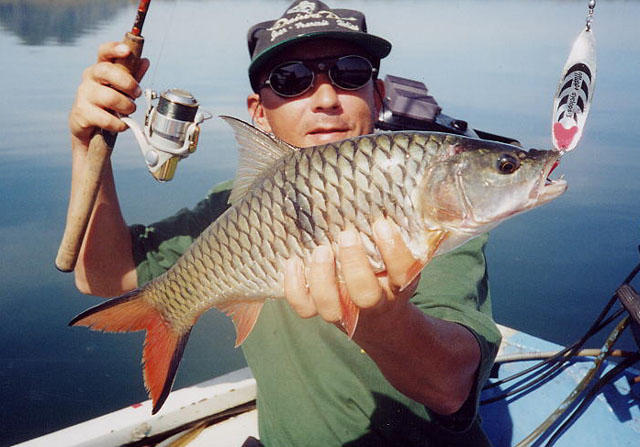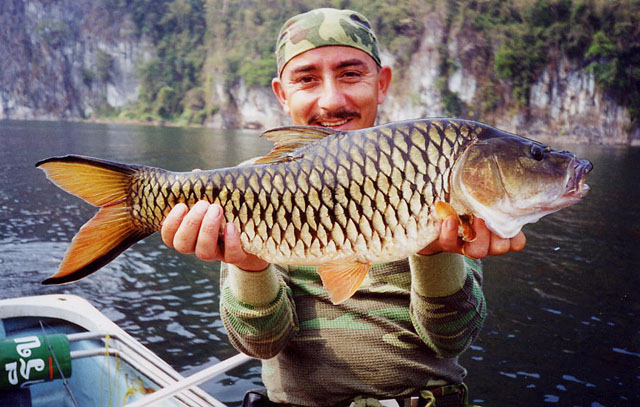Hampala
macrolepidota
Kuhl &
Van Hasselt,
1823
Hampala barb
View all media / Upload your photos and videos
Expand all
Classification / Names
Teleostei (teleosts) > Cypriniformes (Carps) >
Cyprinidae (Minnows or carps)
> Smiliogastrinae
Etymology: Hampala: Local name from Java; in Van Hasselt, "Poissons of Java", 1823
More on authors:
Kuhl &
Van Hasselt.
Environment / milieu / depth range / climate zone / distribution range
Distribution
Asia: Mekong and Chao Phraya basins, Malay Peninsula and Indonesia.
Length at first maturity / Size / Weight / Age
Short description
Dorsal soft rays (total): 11; Anal soft rays: 8. Has a black bar between the dorsal and pelvic fins in adults; orange to red caudal fin with a black longitudinal, marginal stripe along each lobe; juveniles usually with an additional vertical bar on the caudal peduncle (Ref. 27732); juveniles with black teardrop-shaped marking on cheek; barbel always longer than eye width (Ref. 12693). Eyes located in upper-side of head; with a vertical groove reaching behind mouth in isthmus; branchial membranes connected and free (Ref. 45536).
Biology
Occurs mainly in clear rivers or streams with running water and sandy to muddy bottoms (Ref. 4832). Found in most water bodies, except small creeks, torrents, and shallow swamps (Ref. 27732, 57235). A migratory species (Ref. 37772). Enters flooded forest (Ref. 9497). Abundant in the Mekong and in the Nam Ngum Reservoir. Found in the basin-wide tributary of the lower Mekong (Ref. 36667). Largest individual believed to be in a pool below the Chendoroh Dam in Perah, Malaysia. A predatory fish: adults mainly piscivorous in Zoo Negara Lake, Malaysia, but in Saguling Reservoir, West Java, 74 % of the diet consists of aquatic insects. Breeds throughout the rainy season (Ref. 12693). Good fish though bony. May be made into `Lap pa'. Marketed fresh (Ref. 12693). Commonly seen in markets; economic important foodfish (Ref. 57235).
Main reference
Roberts, T.R. 1989 The freshwater fishes of Western Borneo (Kalimantan Barat, Indonesia). Mem. Calif. Acad. Sci. 14:210 p. (Ref. 2091)
IUCN Red List Status (Ref. 125652)
Least Concern (LC); date assessed: February 01 2019
CITES (Ref. 131153)
Not Evaluated
CMS (Ref. 116361)
Not Evaluated
Threat to humans
Harmless
More information
- Countries
- FAO areas
- Ecosystems
- Occurrences
- Introductions
- Stocks
- Ecology
- Diet
- Food items
- Food consumption
- Ration
- Common names
- Synonyms
- Metabolism
- Predators
- Ecotoxicology
- Reproduction
- Maturity
- Spawning
- Spawning aggregation
- Fecundity
- Eggs
- Egg development
- Age/Size
- Growth
- Length-weight
- Length-length
- Length-frequencies
- Morphometrics
- Morphology
- Larvae
- Larval dynamics
- Recruitment
- Abundance
- References
- Aquaculture
- Aquaculture profile
- Strains
- Genetics
- Allele frequencies
- Heritability
- Diseases
- Processing
- Mass conversion
- Vision
- Pictures
- Stamps, Coins Misc.
- Sounds
- Ciguatera
- Speed
- Swim. type
- Gill area
- Otoliths
- Brains
Estimates based on models
Phylogenetic diversity index (Ref. 82804): PD50 = 0.5078 [Uniqueness, from 0.5 = low to 2.0 = high].
Bayesian length-weight: a=0.01072 (0.00920 - 0.01248), b=3.01 (2.97 - 3.05), in cm total length, based on LWR estimates for this species (Ref. 93245).
Trophic level (Ref. 69278): 4.2 ±0.8 se; Based on diet studies.
Generation time: 3.1 ( na - na) years. Estimated as median ln(3)/K based on 1 growth studies.
Resilience (Ref. 120179): Medium, minimum population doubling time 1.4 - 4.4 years (K=0.68; Fec=7,132).
Fishing vulnerability (Ref. 59153): Moderate vulnerability (36 of 100).
Price category (Ref. 80766): Unknown.
Nutrients (Ref. 124155): Calcium = 132 [79, 276] mg/100g; Iron = 1.72 [1.04, 2.76] mg/100g; Protein = 18.6 [16.6, 20.5] %; Omega3 = 0.537 [0.225, 1.290] g/100g; Selenium = 82 [34, 175] μg/100g; VitaminA = 61.9 [20.4, 194.2] μg/100g; Zinc = 1.11 [0.78, 1.62] mg/100g (wet weight); based on nutrient studies.

